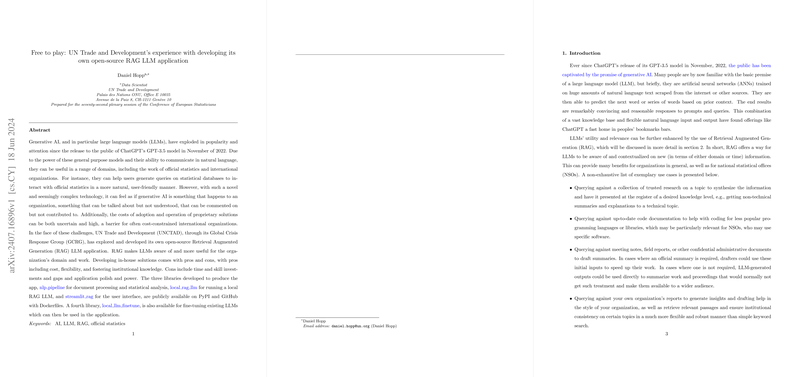Overview of UNCTAD's Open-Source RAG LLM Application Development
The paper "Free to play: UN Trade and Development's experience with developing its own open-source RAG LLM application" explores the development of an autonomous Retrieval Augmented Generation (RAG) LLM application by UN Trade and Development (UNCTAD). This initiative emerged as a solution to the growing need for cost-effective, flexible AI solutions within international organizations.
Background and Motivation
The advent of OpenAI's ChatGPT ushered in widespread interest in generative AI, with LLMs demonstrating their utility across various domains, including official statistics and international agencies. Despite their potential, the proprietary nature and high operational costs of existing AI models present significant barriers for organizations like UNCTAD. In response, UNCTAD, through its Global Crisis Response Group (GCRG), embarked on an initiative to create an open-source LLM application tailored to its specific needs. This decision was driven by considerations of cost, flexibility, and the importance of developing institutional knowledge.
Technical Implementation
UNCTAD's solution involves the creation of a RAG LLM application, which addresses LLMs' intrinsic limitations related to their training data. LLMs often lack current or domain-specific information due to the static nature of their training. RAG enhances LLMs by incorporating a retrieval step that queries a vector database to supply the model with relevant, up-to-date information. UNCTAD's approach leverages several open-source technologies:
- Document Processing and Embedding: Utilizing the
nlp_pipelinelibrary for text conversion and metadata enrichment, making it compatible with the embedding process. - Vector Database: Implementing
pgvectorwith PostgreSQL for vector storage and retrieval. - User Interface: Deploying
streamlit_ragfor a streamlined user experience. - Fine-Tuning Capabilities: Employing the
local_LLM_finetunelibrary for domain-specific model adjustment, enhancing the LLM's applicability to UNCTAD's corpus.
These components collectively facilitate an adaptable, user-oriented application capable of handling a variety of queries within the constraints of UNCTAD's domain.
Advantages of the In-House Development Approach
- Cost Efficiency: Developing an in-house solution primarily involves staff salaries and infrastructure costs, avoiding unpredictable pricing models associated with proprietary services.
- Flexibility and Control: The open-source approach provides significant flexibility in adapting the application to specific organizational needs without dependency on external providers, avoiding potential limitations from commercial offerings.
- Institutional Knowledge and Capacity Building: Building the application internally fosters technical expertise, enhancing the organization’s ability to innovate and operate independently of third-party technologies.
- Data Privacy: The solution ensures data is confined to organizationally controlled environments, mitigating risks associated with external data handling and breaches.
Challenges and Constraints
Despite the evident advantages, in-house development presents challenges, including the requirement for skilled personnel and the potential scalability issues that proprietary solutions typically alleviate. Additionally, open-source models may lag behind in performance compared to frontier proprietary LLMs.
Implications and Future Directions
The successful deployment of UNCTAD's application underscores the feasibility of open-source solutions for international organizations, promoting a model of innovation that aligns with institutional constraints. Future enhancements may involve further optimizing the RAG pipeline, fine-tuning models with more sophisticated datasets, and exploring hybrid models that integrate both proprietary and open-source components to balance performance and cost.
Conclusion
UNCTAD's experience provides valuable insights into how international organizations can leverage open-source AI technologies to meet their unique requirements without incurring substantial costs. The approach detailed in this paper not only exemplifies a pragmatic pathway for adopting AI but also enriches the broader open-source ecosystem, potentially inspiring similar initiatives among national statistics offices and beyond. Through sharing its journey, UNCTAD contributes to a growing body of knowledge, facilitating broader access to advanced AI technologies within the global development community.
